Fall Prevention and Exercise Intervention
VerifiedAdded on 2023/03/20
|13
|1633
|53
Presentation
AI Summary
This presentation focuses on fall prevention among older adults and the application of exercise as an intervention. It discusses the significance of preventing falls, the effectiveness of exercise programs, and the role of healthcare policies in New Zealand. The presentation also explores different types of interventions and their impact on reducing fall risk.
Contribute Materials
Your contribution can guide someone’s learning journey. Share your
documents today.
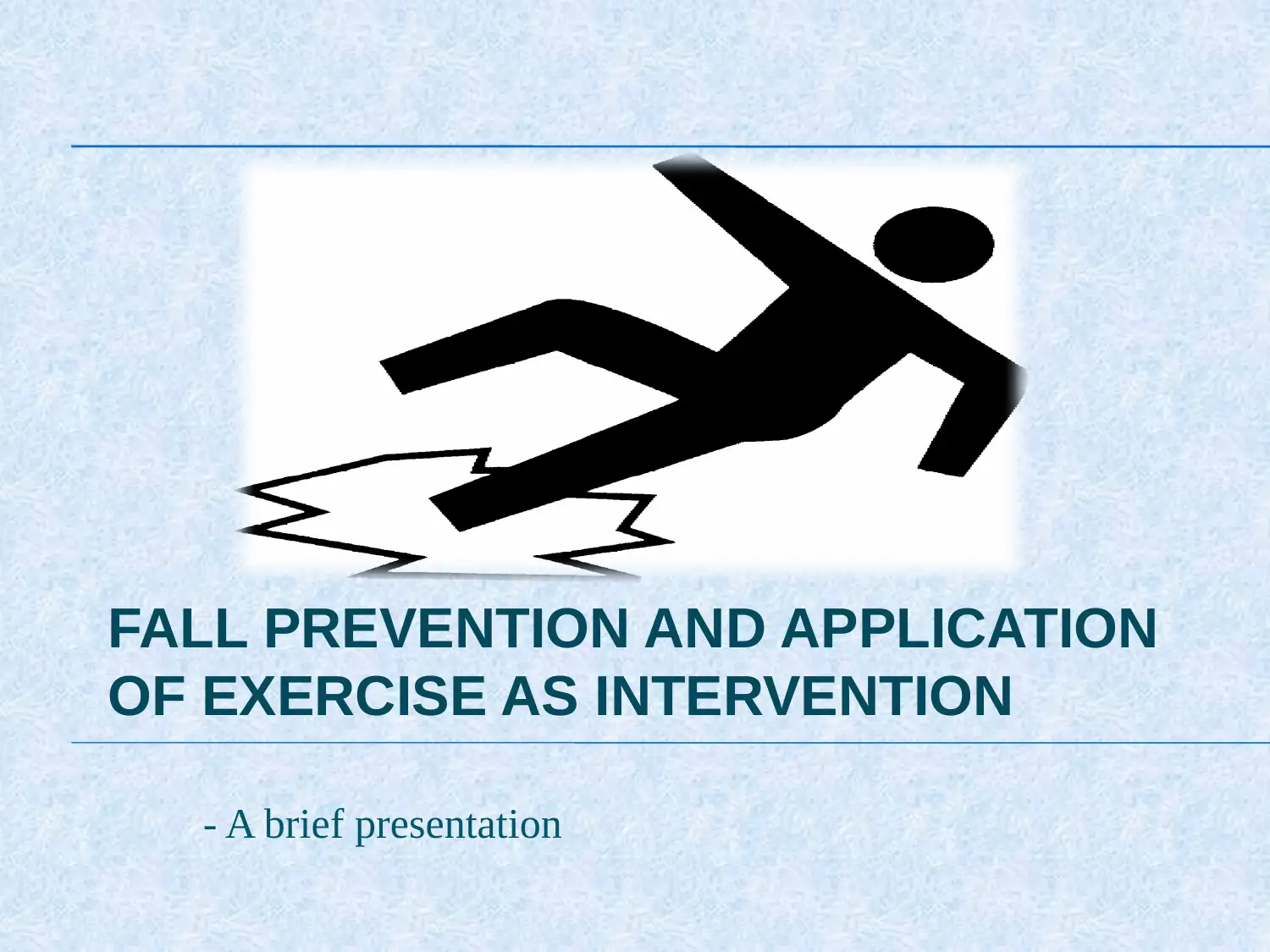
FALL PREVENTION AND APPLICATION
OF EXERCISE AS INTERVENTION
- A brief presentation
OF EXERCISE AS INTERVENTION
- A brief presentation
Secure Best Marks with AI Grader
Need help grading? Try our AI Grader for instant feedback on your assignments.
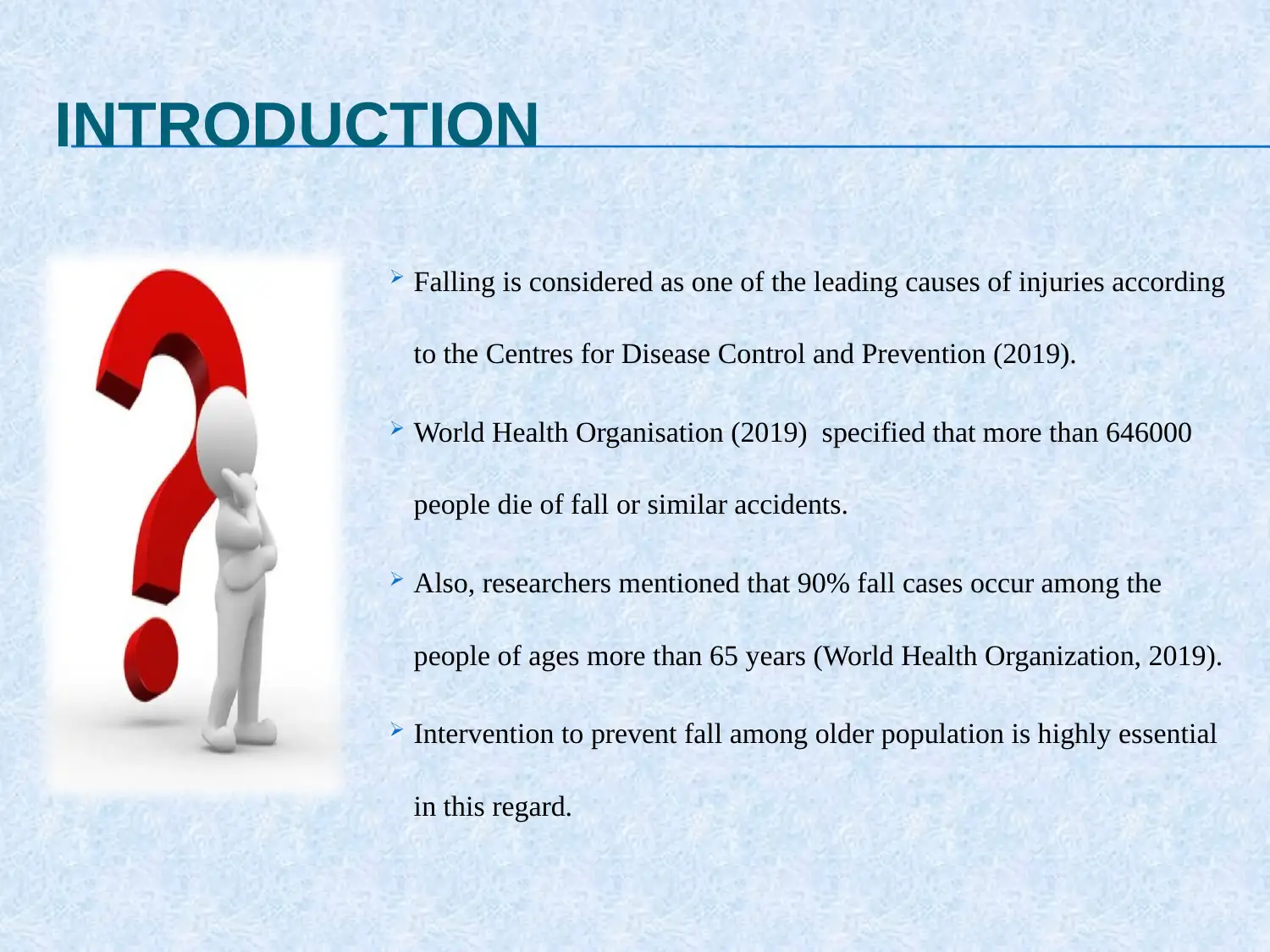
INTRODUCTION
Falling is considered as one of the leading causes of injuries according
to the Centres for Disease Control and Prevention (2019).
World Health Organisation (2019) specified that more than 646000
people die of fall or similar accidents.
Also, researchers mentioned that 90% fall cases occur among the
people of ages more than 65 years (World Health Organization, 2019).
Intervention to prevent fall among older population is highly essential
in this regard.
Falling is considered as one of the leading causes of injuries according
to the Centres for Disease Control and Prevention (2019).
World Health Organisation (2019) specified that more than 646000
people die of fall or similar accidents.
Also, researchers mentioned that 90% fall cases occur among the
people of ages more than 65 years (World Health Organization, 2019).
Intervention to prevent fall among older population is highly essential
in this regard.
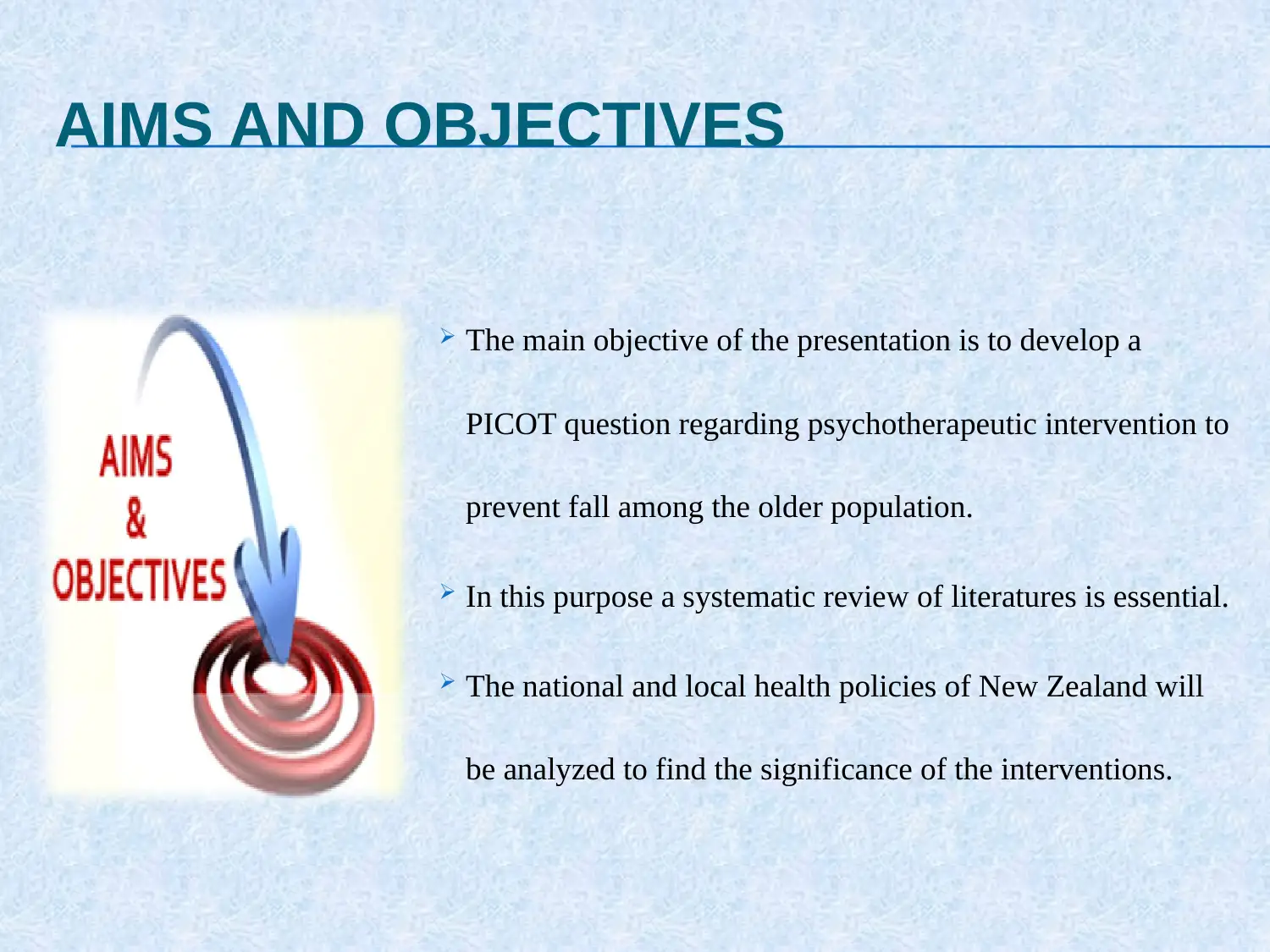
AIMS AND OBJECTIVES
The main objective of the presentation is to develop a
PICOT question regarding psychotherapeutic intervention to
prevent fall among the older population.
In this purpose a systematic review of literatures is essential.
The national and local health policies of New Zealand will
be analyzed to find the significance of the interventions.
The main objective of the presentation is to develop a
PICOT question regarding psychotherapeutic intervention to
prevent fall among the older population.
In this purpose a systematic review of literatures is essential.
The national and local health policies of New Zealand will
be analyzed to find the significance of the interventions.
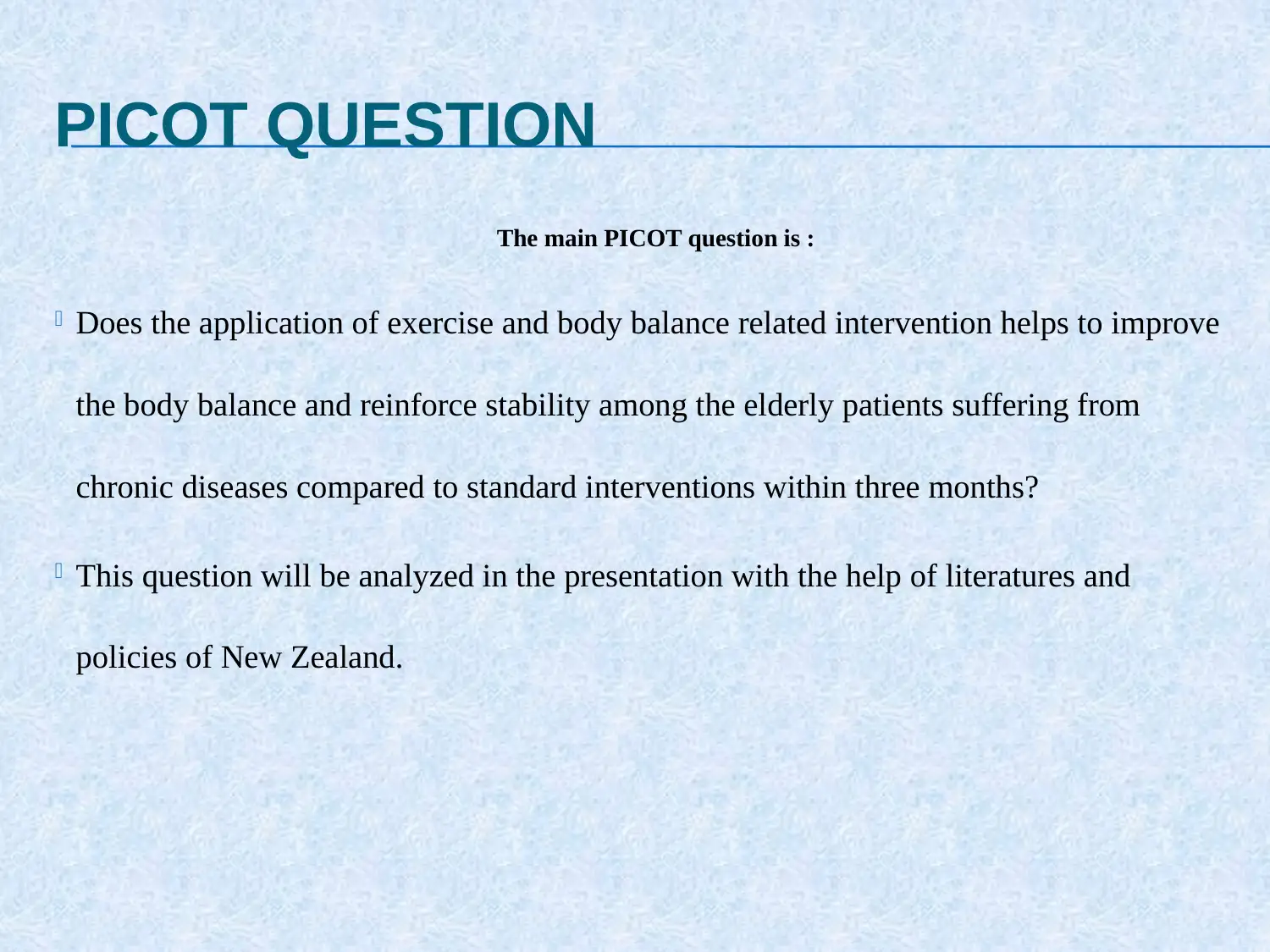
PICOT QUESTION
The main PICOT question is :
Does the application of exercise and body balance related intervention helps to improve
the body balance and reinforce stability among the elderly patients suffering from
chronic diseases compared to standard interventions within three months?
This question will be analyzed in the presentation with the help of literatures and
policies of New Zealand.
The main PICOT question is :
Does the application of exercise and body balance related intervention helps to improve
the body balance and reinforce stability among the elderly patients suffering from
chronic diseases compared to standard interventions within three months?
This question will be analyzed in the presentation with the help of literatures and
policies of New Zealand.
Secure Best Marks with AI Grader
Need help grading? Try our AI Grader for instant feedback on your assignments.
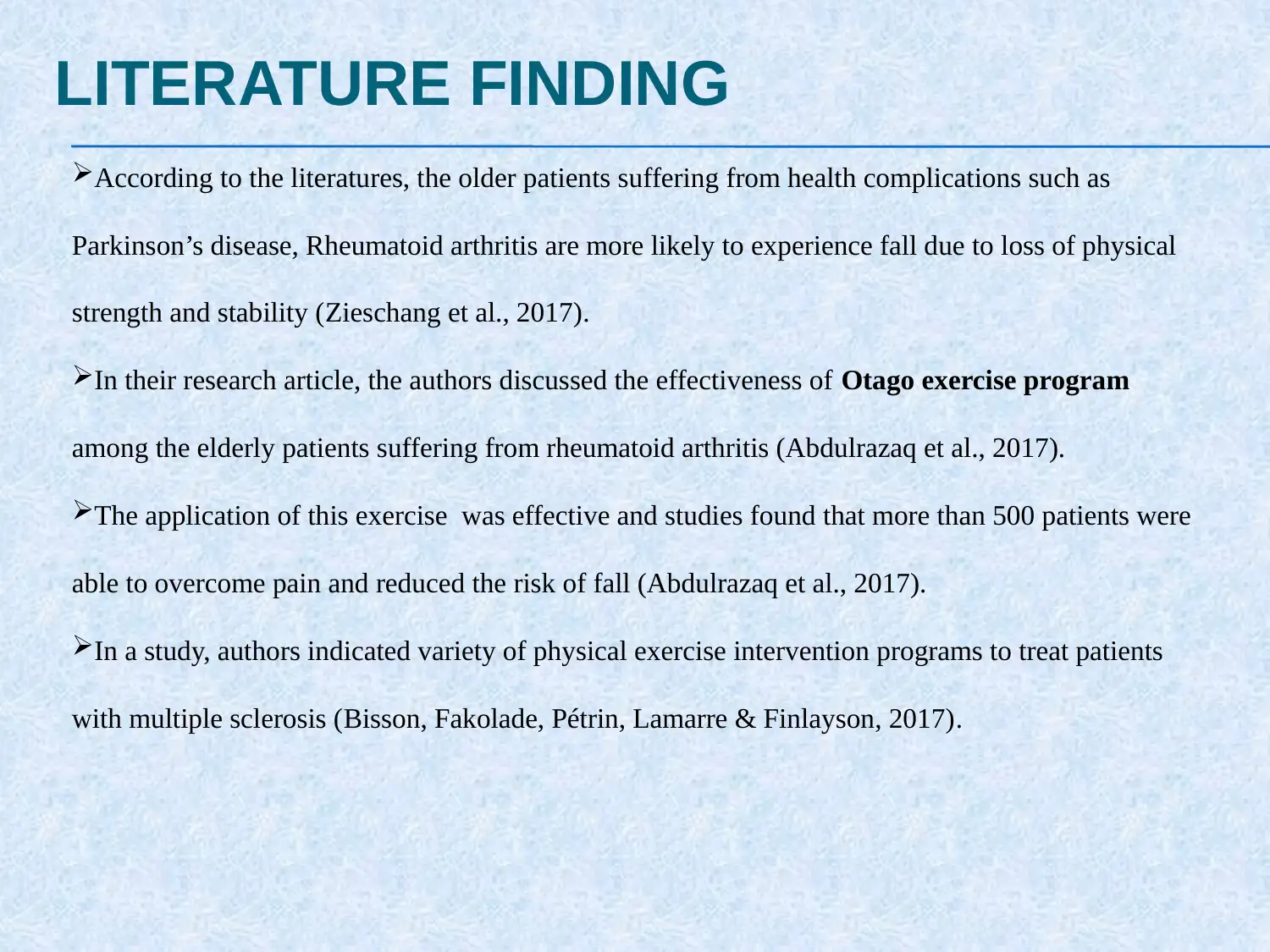
LITERATURE FINDING
According to the literatures, the older patients suffering from health complications such as
Parkinson’s disease, Rheumatoid arthritis are more likely to experience fall due to loss of physical
strength and stability (Zieschang et al., 2017).
In their research article, the authors discussed the effectiveness of Otago exercise program
among the elderly patients suffering from rheumatoid arthritis (Abdulrazaq et al., 2017).
The application of this exercise was effective and studies found that more than 500 patients were
able to overcome pain and reduced the risk of fall (Abdulrazaq et al., 2017).
In a study, authors indicated variety of physical exercise intervention programs to treat patients
with multiple sclerosis (Bisson, Fakolade, Pétrin, Lamarre & Finlayson, 2017).
According to the literatures, the older patients suffering from health complications such as
Parkinson’s disease, Rheumatoid arthritis are more likely to experience fall due to loss of physical
strength and stability (Zieschang et al., 2017).
In their research article, the authors discussed the effectiveness of Otago exercise program
among the elderly patients suffering from rheumatoid arthritis (Abdulrazaq et al., 2017).
The application of this exercise was effective and studies found that more than 500 patients were
able to overcome pain and reduced the risk of fall (Abdulrazaq et al., 2017).
In a study, authors indicated variety of physical exercise intervention programs to treat patients
with multiple sclerosis (Bisson, Fakolade, Pétrin, Lamarre & Finlayson, 2017).
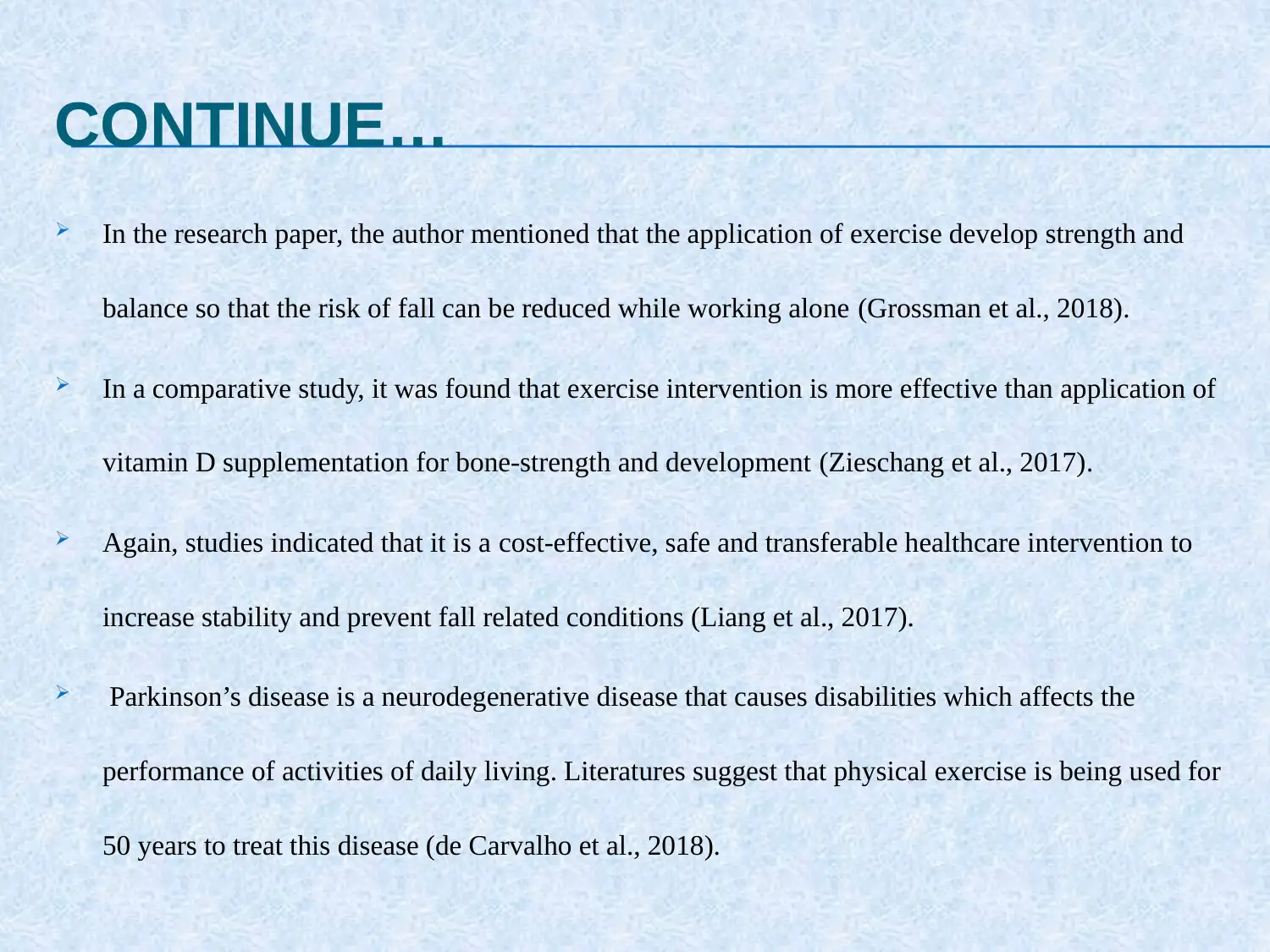
CONTINUE…
In the research paper, the author mentioned that the application of exercise develop strength and
balance so that the risk of fall can be reduced while working alone (Grossman et al., 2018).
In a comparative study, it was found that exercise intervention is more effective than application of
vitamin D supplementation for bone-strength and development (Zieschang et al., 2017).
Again, studies indicated that it is a cost-effective, safe and transferable healthcare intervention to
increase stability and prevent fall related conditions (Liang et al., 2017).
Parkinson’s disease is a neurodegenerative disease that causes disabilities which affects the
performance of activities of daily living. Literatures suggest that physical exercise is being used for
50 years to treat this disease (de Carvalho et al., 2018).
In the research paper, the author mentioned that the application of exercise develop strength and
balance so that the risk of fall can be reduced while working alone (Grossman et al., 2018).
In a comparative study, it was found that exercise intervention is more effective than application of
vitamin D supplementation for bone-strength and development (Zieschang et al., 2017).
Again, studies indicated that it is a cost-effective, safe and transferable healthcare intervention to
increase stability and prevent fall related conditions (Liang et al., 2017).
Parkinson’s disease is a neurodegenerative disease that causes disabilities which affects the
performance of activities of daily living. Literatures suggest that physical exercise is being used for
50 years to treat this disease (de Carvalho et al., 2018).
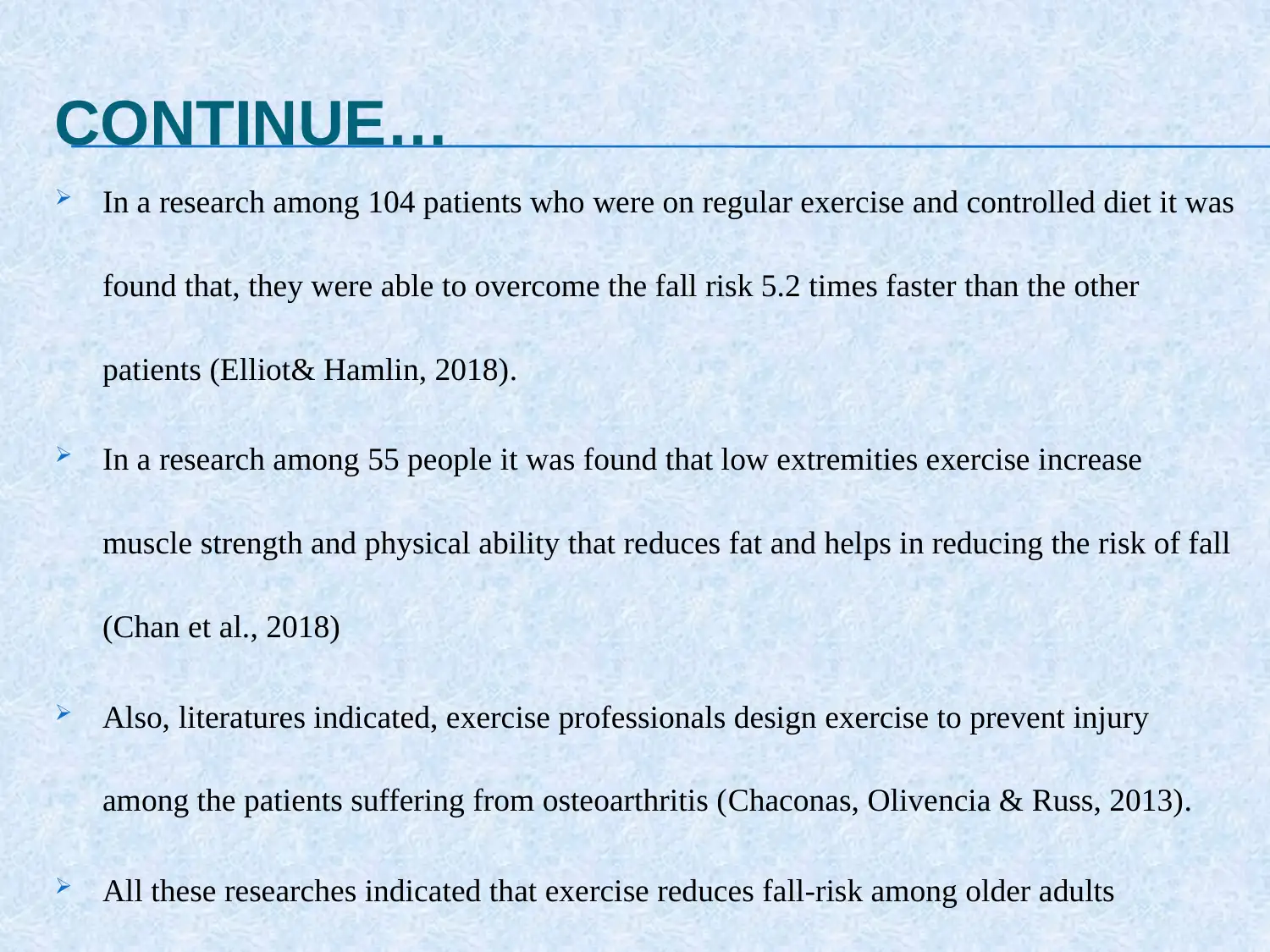
CONTINUE…
In a research among 104 patients who were on regular exercise and controlled diet it was
found that, they were able to overcome the fall risk 5.2 times faster than the other
patients (Elliot& Hamlin, 2018).
In a research among 55 people it was found that low extremities exercise increase
muscle strength and physical ability that reduces fat and helps in reducing the risk of fall
(Chan et al., 2018)
Also, literatures indicated, exercise professionals design exercise to prevent injury
among the patients suffering from osteoarthritis (Chaconas, Olivencia & Russ, 2013).
All these researches indicated that exercise reduces fall-risk among older adults
In a research among 104 patients who were on regular exercise and controlled diet it was
found that, they were able to overcome the fall risk 5.2 times faster than the other
patients (Elliot& Hamlin, 2018).
In a research among 55 people it was found that low extremities exercise increase
muscle strength and physical ability that reduces fat and helps in reducing the risk of fall
(Chan et al., 2018)
Also, literatures indicated, exercise professionals design exercise to prevent injury
among the patients suffering from osteoarthritis (Chaconas, Olivencia & Russ, 2013).
All these researches indicated that exercise reduces fall-risk among older adults
Paraphrase This Document
Need a fresh take? Get an instant paraphrase of this document with our AI Paraphraser
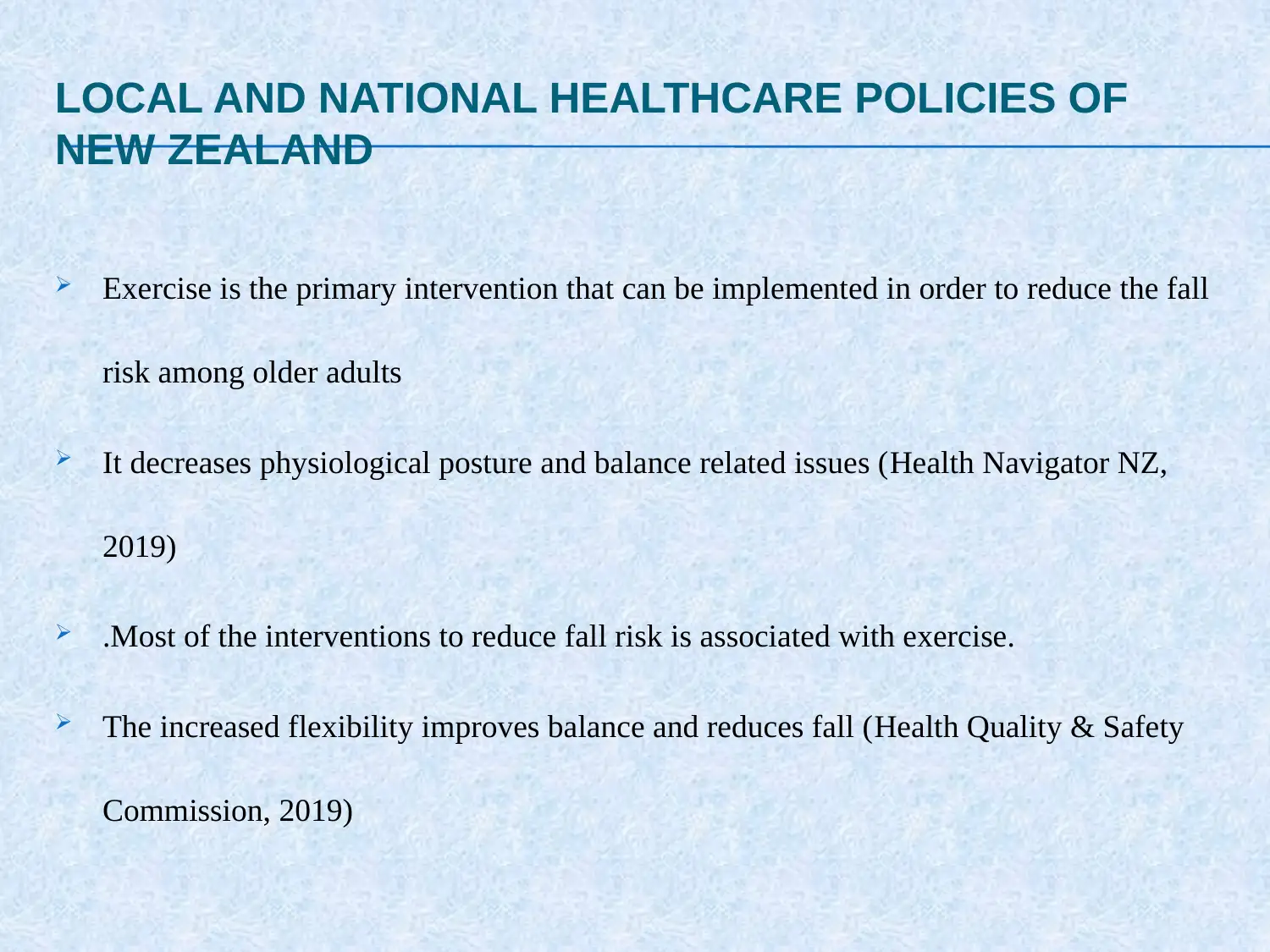
LOCAL AND NATIONAL HEALTHCARE POLICIES OF
NEW ZEALAND
Exercise is the primary intervention that can be implemented in order to reduce the fall
risk among older adults
It decreases physiological posture and balance related issues (Health Navigator NZ,
2019)
.Most of the interventions to reduce fall risk is associated with exercise.
The increased flexibility improves balance and reduces fall (Health Quality & Safety
Commission, 2019)
NEW ZEALAND
Exercise is the primary intervention that can be implemented in order to reduce the fall
risk among older adults
It decreases physiological posture and balance related issues (Health Navigator NZ,
2019)
.Most of the interventions to reduce fall risk is associated with exercise.
The increased flexibility improves balance and reduces fall (Health Quality & Safety
Commission, 2019)
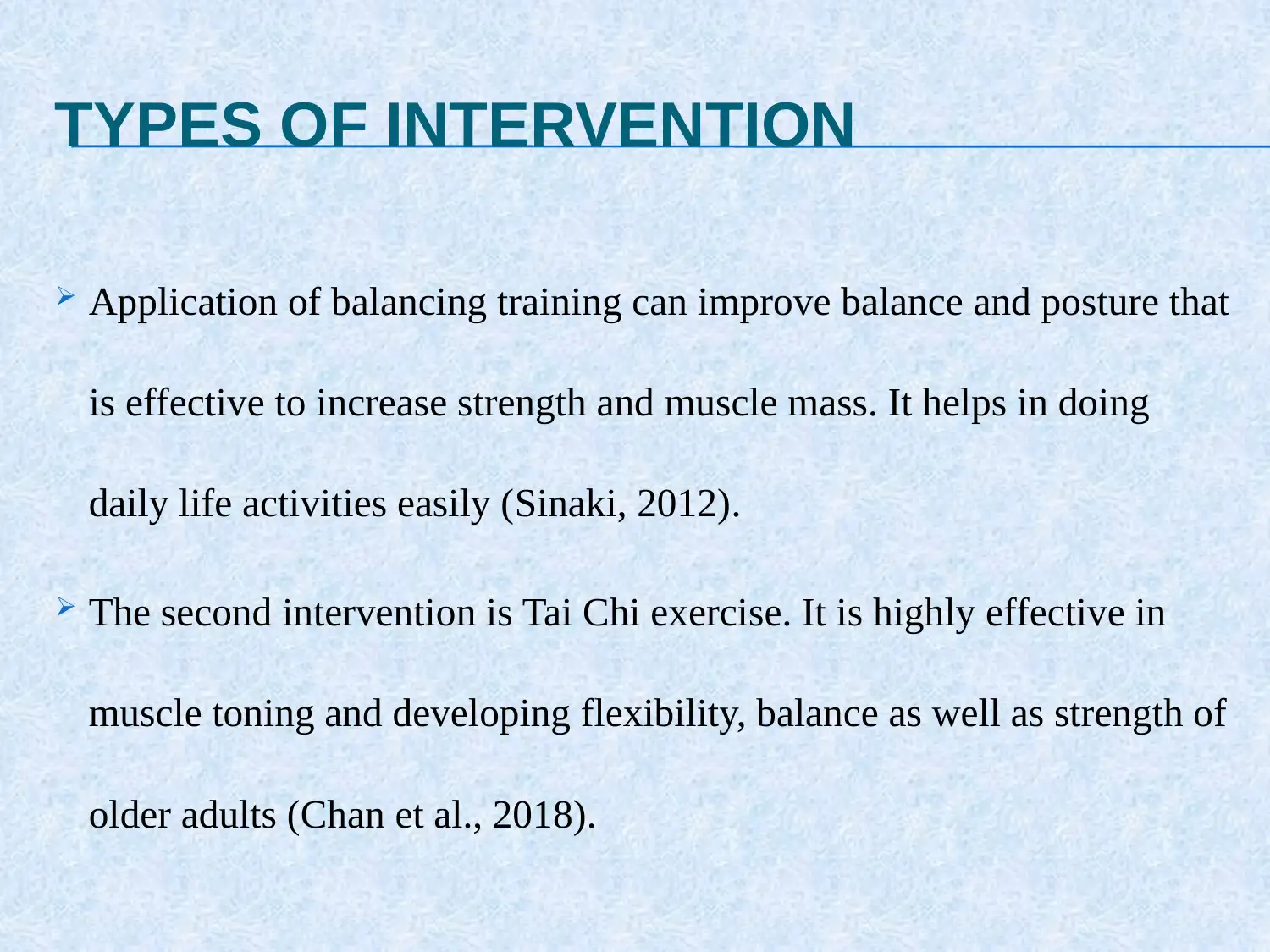
TYPES OF INTERVENTION
Application of balancing training can improve balance and posture that
is effective to increase strength and muscle mass. It helps in doing
daily life activities easily (Sinaki, 2012).
The second intervention is Tai Chi exercise. It is highly effective in
muscle toning and developing flexibility, balance as well as strength of
older adults (Chan et al., 2018).
Application of balancing training can improve balance and posture that
is effective to increase strength and muscle mass. It helps in doing
daily life activities easily (Sinaki, 2012).
The second intervention is Tai Chi exercise. It is highly effective in
muscle toning and developing flexibility, balance as well as strength of
older adults (Chan et al., 2018).
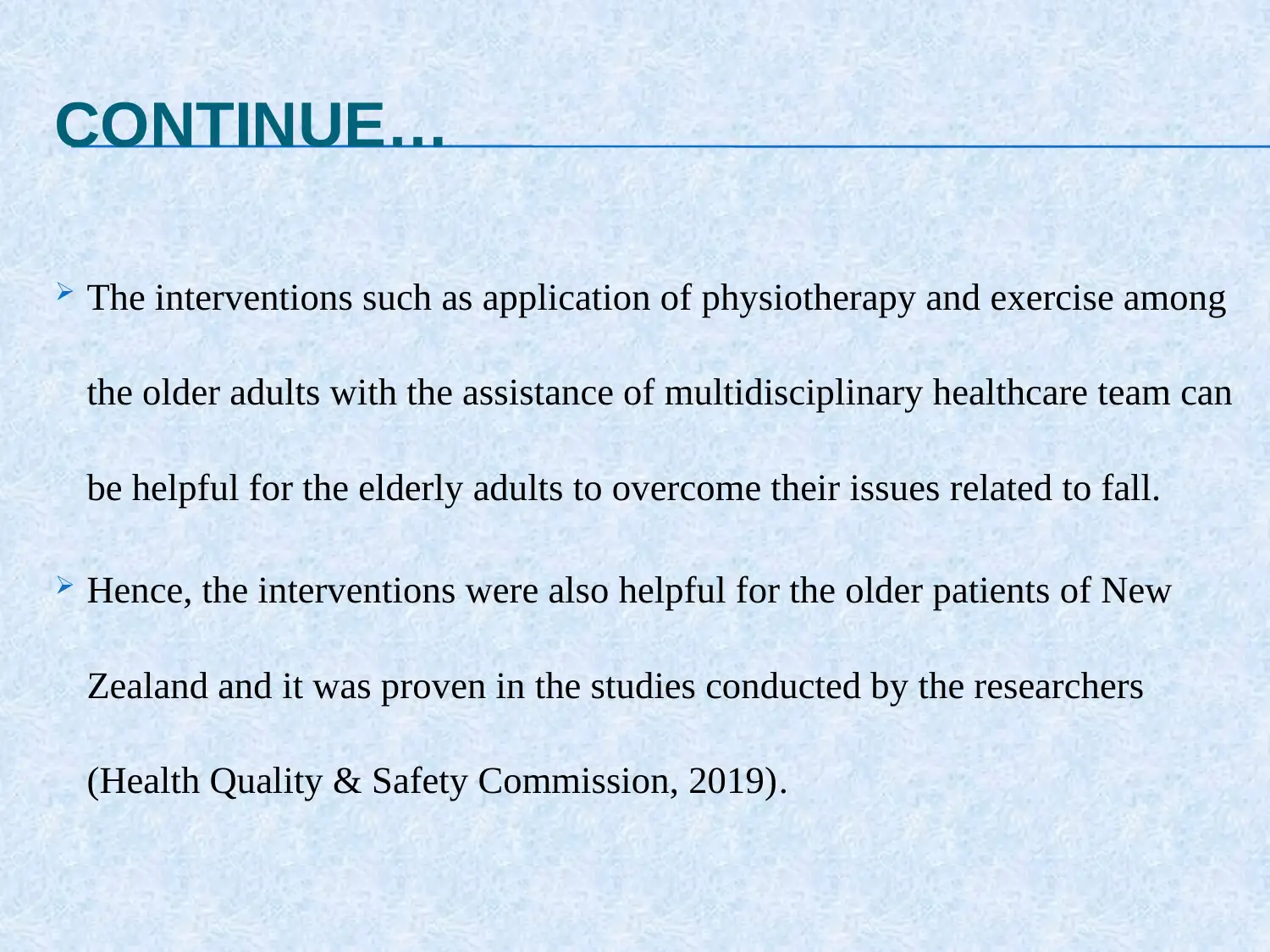
CONTINUE…
The interventions such as application of physiotherapy and exercise among
the older adults with the assistance of multidisciplinary healthcare team can
be helpful for the elderly adults to overcome their issues related to fall.
Hence, the interventions were also helpful for the older patients of New
Zealand and it was proven in the studies conducted by the researchers
(Health Quality & Safety Commission, 2019).
The interventions such as application of physiotherapy and exercise among
the older adults with the assistance of multidisciplinary healthcare team can
be helpful for the elderly adults to overcome their issues related to fall.
Hence, the interventions were also helpful for the older patients of New
Zealand and it was proven in the studies conducted by the researchers
(Health Quality & Safety Commission, 2019).
Secure Best Marks with AI Grader
Need help grading? Try our AI Grader for instant feedback on your assignments.
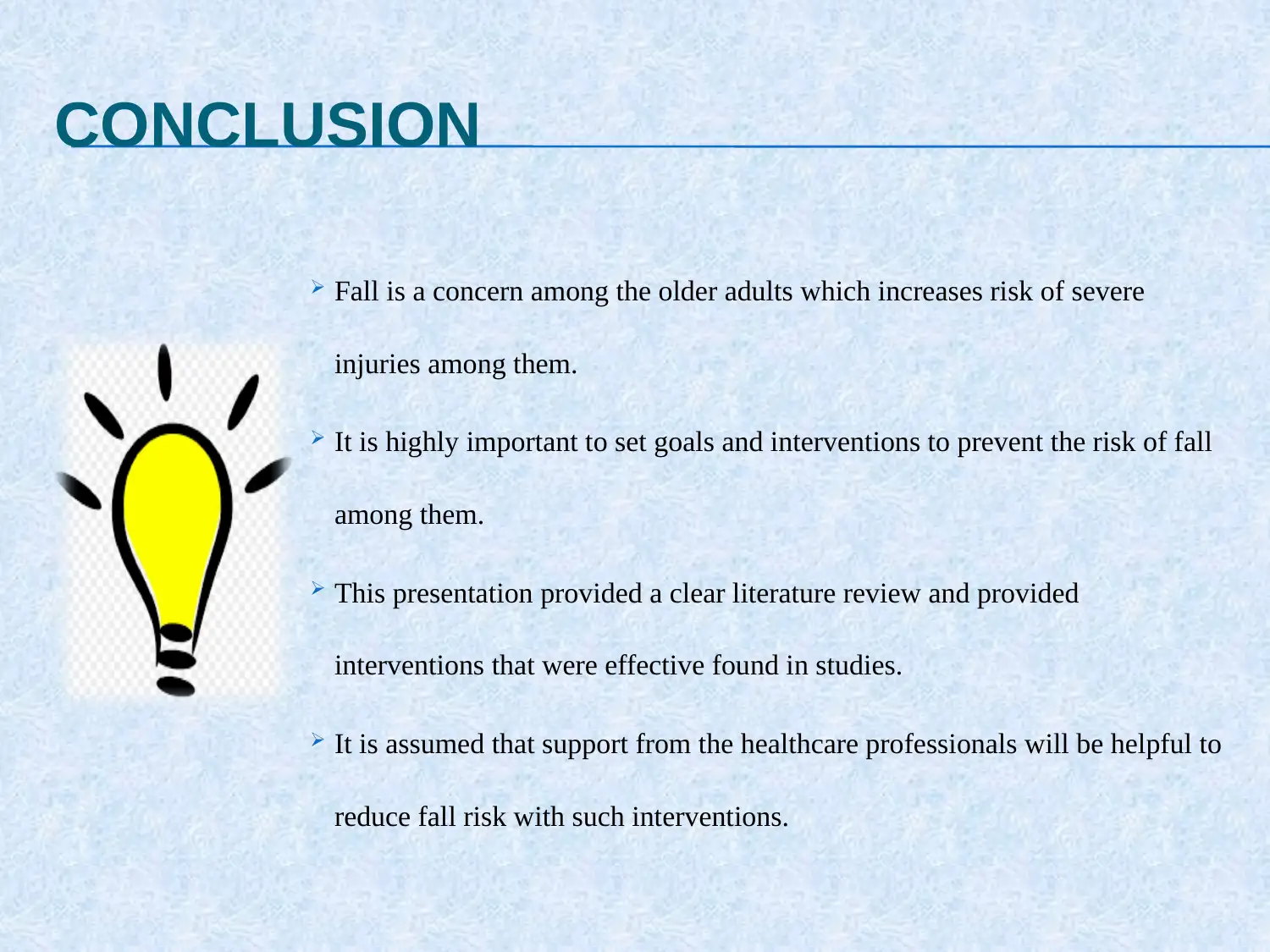
CONCLUSION
Fall is a concern among the older adults which increases risk of severe
injuries among them.
It is highly important to set goals and interventions to prevent the risk of fall
among them.
This presentation provided a clear literature review and provided
interventions that were effective found in studies.
It is assumed that support from the healthcare professionals will be helpful to
reduce fall risk with such interventions.
Fall is a concern among the older adults which increases risk of severe
injuries among them.
It is highly important to set goals and interventions to prevent the risk of fall
among them.
This presentation provided a clear literature review and provided
interventions that were effective found in studies.
It is assumed that support from the healthcare professionals will be helpful to
reduce fall risk with such interventions.
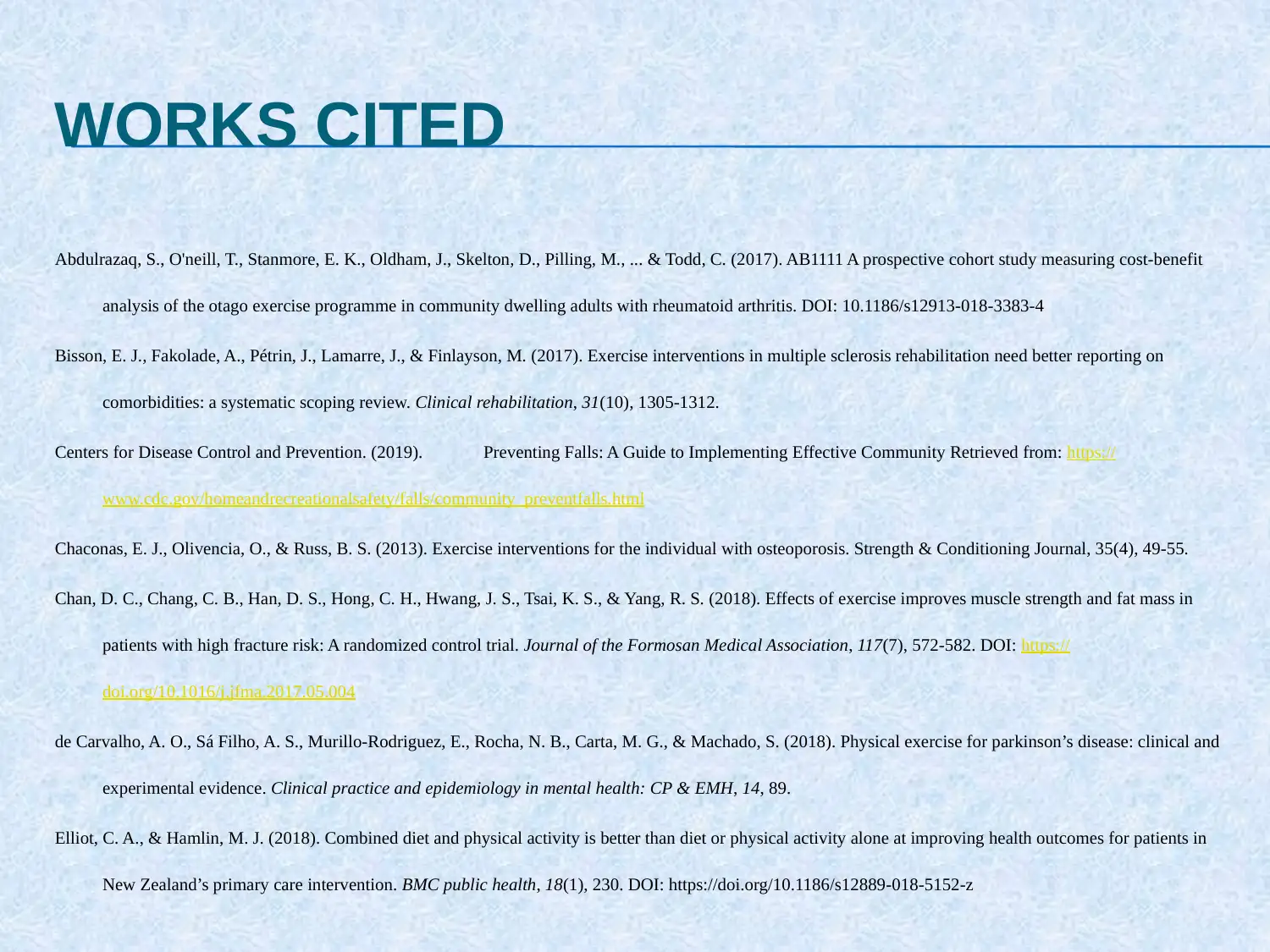
WORKS CITED
Abdulrazaq, S., O'neill, T., Stanmore, E. K., Oldham, J., Skelton, D., Pilling, M., ... & Todd, C. (2017). AB1111 A prospective cohort study measuring cost-benefit
analysis of the otago exercise programme in community dwelling adults with rheumatoid arthritis. DOI: 10.1186/s12913-018-3383-4
Bisson, E. J., Fakolade, A., Pétrin, J., Lamarre, J., & Finlayson, M. (2017). Exercise interventions in multiple sclerosis rehabilitation need better reporting on
comorbidities: a systematic scoping review. Clinical rehabilitation, 31(10), 1305-1312.
Centers for Disease Control and Prevention. (2019). Preventing Falls: A Guide to Implementing Effective Community Retrieved from: https://
www.cdc.gov/homeandrecreationalsafety/falls/community_preventfalls.html
Chaconas, E. J., Olivencia, O., & Russ, B. S. (2013). Exercise interventions for the individual with osteoporosis. Strength & Conditioning Journal, 35(4), 49-55.
Chan, D. C., Chang, C. B., Han, D. S., Hong, C. H., Hwang, J. S., Tsai, K. S., & Yang, R. S. (2018). Effects of exercise improves muscle strength and fat mass in
patients with high fracture risk: A randomized control trial. Journal of the Formosan Medical Association, 117(7), 572-582. DOI: https://
doi.org/10.1016/j.jfma.2017.05.004
de Carvalho, A. O., Sá Filho, A. S., Murillo-Rodriguez, E., Rocha, N. B., Carta, M. G., & Machado, S. (2018). Physical exercise for parkinson’s disease: clinical and
experimental evidence. Clinical practice and epidemiology in mental health: CP & EMH, 14, 89.
Elliot, C. A., & Hamlin, M. J. (2018). Combined diet and physical activity is better than diet or physical activity alone at improving health outcomes for patients in
New Zealand’s primary care intervention. BMC public health, 18(1), 230. DOI: https://doi.org/10.1186/s12889-018-5152-z
Abdulrazaq, S., O'neill, T., Stanmore, E. K., Oldham, J., Skelton, D., Pilling, M., ... & Todd, C. (2017). AB1111 A prospective cohort study measuring cost-benefit
analysis of the otago exercise programme in community dwelling adults with rheumatoid arthritis. DOI: 10.1186/s12913-018-3383-4
Bisson, E. J., Fakolade, A., Pétrin, J., Lamarre, J., & Finlayson, M. (2017). Exercise interventions in multiple sclerosis rehabilitation need better reporting on
comorbidities: a systematic scoping review. Clinical rehabilitation, 31(10), 1305-1312.
Centers for Disease Control and Prevention. (2019). Preventing Falls: A Guide to Implementing Effective Community Retrieved from: https://
www.cdc.gov/homeandrecreationalsafety/falls/community_preventfalls.html
Chaconas, E. J., Olivencia, O., & Russ, B. S. (2013). Exercise interventions for the individual with osteoporosis. Strength & Conditioning Journal, 35(4), 49-55.
Chan, D. C., Chang, C. B., Han, D. S., Hong, C. H., Hwang, J. S., Tsai, K. S., & Yang, R. S. (2018). Effects of exercise improves muscle strength and fat mass in
patients with high fracture risk: A randomized control trial. Journal of the Formosan Medical Association, 117(7), 572-582. DOI: https://
doi.org/10.1016/j.jfma.2017.05.004
de Carvalho, A. O., Sá Filho, A. S., Murillo-Rodriguez, E., Rocha, N. B., Carta, M. G., & Machado, S. (2018). Physical exercise for parkinson’s disease: clinical and
experimental evidence. Clinical practice and epidemiology in mental health: CP & EMH, 14, 89.
Elliot, C. A., & Hamlin, M. J. (2018). Combined diet and physical activity is better than diet or physical activity alone at improving health outcomes for patients in
New Zealand’s primary care intervention. BMC public health, 18(1), 230. DOI: https://doi.org/10.1186/s12889-018-5152-z
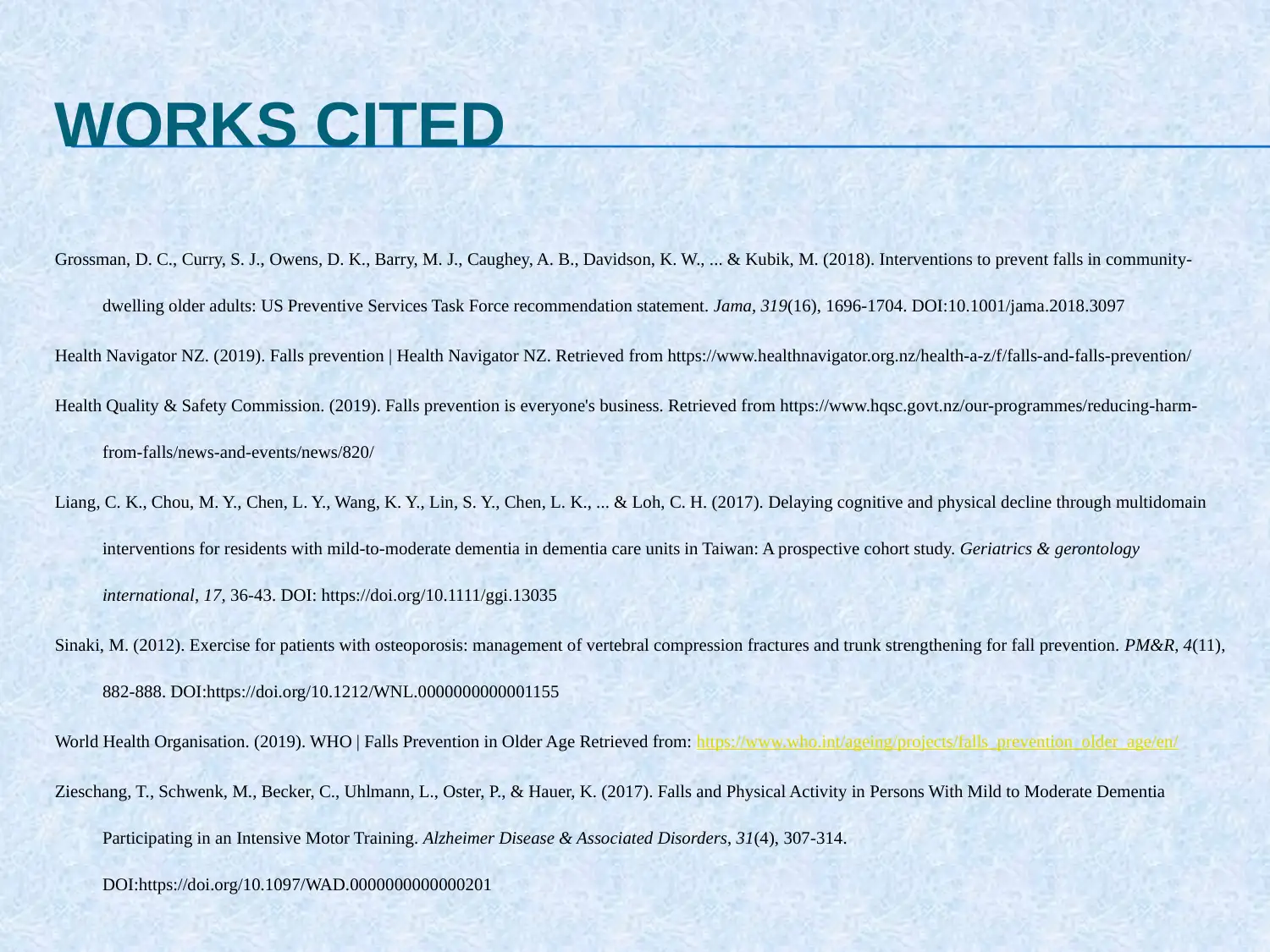
WORKS CITED
Grossman, D. C., Curry, S. J., Owens, D. K., Barry, M. J., Caughey, A. B., Davidson, K. W., ... & Kubik, M. (2018). Interventions to prevent falls in community-
dwelling older adults: US Preventive Services Task Force recommendation statement. Jama, 319(16), 1696-1704. DOI:10.1001/jama.2018.3097
Health Navigator NZ. (2019). Falls prevention | Health Navigator NZ. Retrieved from https://www.healthnavigator.org.nz/health-a-z/f/falls-and-falls-prevention/
Health Quality & Safety Commission. (2019). Falls prevention is everyone's business. Retrieved from https://www.hqsc.govt.nz/our-programmes/reducing-harm-
from-falls/news-and-events/news/820/
Liang, C. K., Chou, M. Y., Chen, L. Y., Wang, K. Y., Lin, S. Y., Chen, L. K., ... & Loh, C. H. (2017). Delaying cognitive and physical decline through multidomain
interventions for residents with mild‐to‐moderate dementia in dementia care units in Taiwan: A prospective cohort study. Geriatrics & gerontology
international, 17, 36-43. DOI: https://doi.org/10.1111/ggi.13035
Sinaki, M. (2012). Exercise for patients with osteoporosis: management of vertebral compression fractures and trunk strengthening for fall prevention. PM&R, 4(11),
882-888. DOI:https://doi.org/10.1212/WNL.0000000000001155
World Health Organisation. (2019). WHO | Falls Prevention in Older Age Retrieved from: https://www.who.int/ageing/projects/falls_prevention_older_age/en/
Zieschang, T., Schwenk, M., Becker, C., Uhlmann, L., Oster, P., & Hauer, K. (2017). Falls and Physical Activity in Persons With Mild to Moderate Dementia
Participating in an Intensive Motor Training. Alzheimer Disease & Associated Disorders, 31(4), 307-314.
DOI:https://doi.org/10.1097/WAD.0000000000000201
Grossman, D. C., Curry, S. J., Owens, D. K., Barry, M. J., Caughey, A. B., Davidson, K. W., ... & Kubik, M. (2018). Interventions to prevent falls in community-
dwelling older adults: US Preventive Services Task Force recommendation statement. Jama, 319(16), 1696-1704. DOI:10.1001/jama.2018.3097
Health Navigator NZ. (2019). Falls prevention | Health Navigator NZ. Retrieved from https://www.healthnavigator.org.nz/health-a-z/f/falls-and-falls-prevention/
Health Quality & Safety Commission. (2019). Falls prevention is everyone's business. Retrieved from https://www.hqsc.govt.nz/our-programmes/reducing-harm-
from-falls/news-and-events/news/820/
Liang, C. K., Chou, M. Y., Chen, L. Y., Wang, K. Y., Lin, S. Y., Chen, L. K., ... & Loh, C. H. (2017). Delaying cognitive and physical decline through multidomain
interventions for residents with mild‐to‐moderate dementia in dementia care units in Taiwan: A prospective cohort study. Geriatrics & gerontology
international, 17, 36-43. DOI: https://doi.org/10.1111/ggi.13035
Sinaki, M. (2012). Exercise for patients with osteoporosis: management of vertebral compression fractures and trunk strengthening for fall prevention. PM&R, 4(11),
882-888. DOI:https://doi.org/10.1212/WNL.0000000000001155
World Health Organisation. (2019). WHO | Falls Prevention in Older Age Retrieved from: https://www.who.int/ageing/projects/falls_prevention_older_age/en/
Zieschang, T., Schwenk, M., Becker, C., Uhlmann, L., Oster, P., & Hauer, K. (2017). Falls and Physical Activity in Persons With Mild to Moderate Dementia
Participating in an Intensive Motor Training. Alzheimer Disease & Associated Disorders, 31(4), 307-314.
DOI:https://doi.org/10.1097/WAD.0000000000000201
1 out of 13
Related Documents
Your All-in-One AI-Powered Toolkit for Academic Success.
+13062052269
info@desklib.com
Available 24*7 on WhatsApp / Email
![[object Object]](/_next/static/media/star-bottom.7253800d.svg)
Unlock your academic potential
© 2024 | Zucol Services PVT LTD | All rights reserved.





